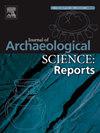Archaeometallurgical characterization of Greco-Roman copper-based and iron nails from Tel Abu Seify, North Sinai, Egypt
IF 1.5
2区 历史学
0 ARCHAEOLOGY
引用次数: 0
Abstract
The current study focuses on the investigation of a collection of copper alloy and iron nails discovered amid numerous metal artifacts in the archaeological excavations of Tel Abu Seify, North Sinai, Egypt. This site, identified as a shipbuilding and repair facility, dates back to the Greco-Roman era (Circa 332BCE–A.D. 641). Different analytical methods were employed to ascertain the composition of the alloys, manufacturing techniques, and characteristics of the corrosion products in the nails. A range of techniques were utilized to achieve this goal, including optical and metallographic microscopy, X-ray radiography, portable X-ray fluorescence, SEM-EDS, micro-Raman spectroscopy, and X-ray diffraction. The results indicated that 19 of the examined nails were composed of copper alloy, except for two nails made of iron. The analysis revealed that the tin bronze nails were predominantly composed of copper, with a minor presence of tin (4.3 wt%), lead (4.7 wt%), and traces of iron and arsenic. Additionally, the iron nails were made of low-carbon iron alloys. Microscopic examination indicated that the nails were manufactured via cold hammering. The patina observed on the copper nails encompassed cuprite, atacamite, clinoatacamite, antlerite, and cerussite, often interspersed with the soil residues. The rust surfaces of the iron nails comprised hematite, magnetite, goethite, akaganeite, and lepidocrocite. The iron nails and some copper nails exhibited partial or total mineralization, whereas most copper nails remained in good condition, generally retaining their metallic cores.
埃及北西奈 Tel Abu Seify 出土的古希腊罗马时期铜钉和铁钉的考古冶金特征分析
本研究的重点是调查在埃及西奈半岛北部 Tel Abu Seify 考古发掘中,在众多金属文物中发现的一批铜合金和铁钉。该遗址被认定为造船和维修设施,其历史可追溯到希腊罗马时代(约公元前 332 年-公元 641 年)。我们采用了不同的分析方法来确定合金的成分、制造技术以及钉子中腐蚀产物的特征。为实现这一目标,采用了一系列技术,包括光学显微镜和金相显微镜、X 射线射线照相术、便携式 X 射线荧光仪、扫描电子显微镜、微拉曼光谱仪和 X 射线衍射仪。结果表明,除两枚铁钉外,19 枚受检铁钉均由铜合金组成。分析表明,锡青铜钉主要由铜组成,少量含有锡(4.3 重量%)、铅(4.7 重量%)以及微量的铁和砷。此外,铁钉由低碳铁合金制成。显微镜检查表明,铁钉是通过冷锤打制而成的。在铜钉上观察到的铜锈包括铜绿石、金星石、金星石、鹿角石和铈石,通常与土壤残留物交织在一起。铁钉的锈面由赤铁矿、磁铁矿、鹅铁矿、赤铁矿和鳞片铁矿组成。铁钉和一些铜钉出现了部分或全部矿化现象,而大多数铜钉则保存完好,一般都保留了金属内核。
本文章由计算机程序翻译,如有差异,请以英文原文为准。
求助全文
约1分钟内获得全文
求助全文
来源期刊

Journal of Archaeological Science-Reports
ARCHAEOLOGY-
CiteScore
3.10
自引率
12.50%
发文量
405
期刊介绍:
Journal of Archaeological Science: Reports is aimed at archaeologists and scientists engaged with the application of scientific techniques and methodologies to all areas of archaeology. The journal focuses on the results of the application of scientific methods to archaeological problems and debates. It will provide a forum for reviews and scientific debate of issues in scientific archaeology and their impact in the wider subject. Journal of Archaeological Science: Reports will publish papers of excellent archaeological science, with regional or wider interest. This will include case studies, reviews and short papers where an established scientific technique sheds light on archaeological questions and debates.
 求助内容:
求助内容: 应助结果提醒方式:
应助结果提醒方式:


